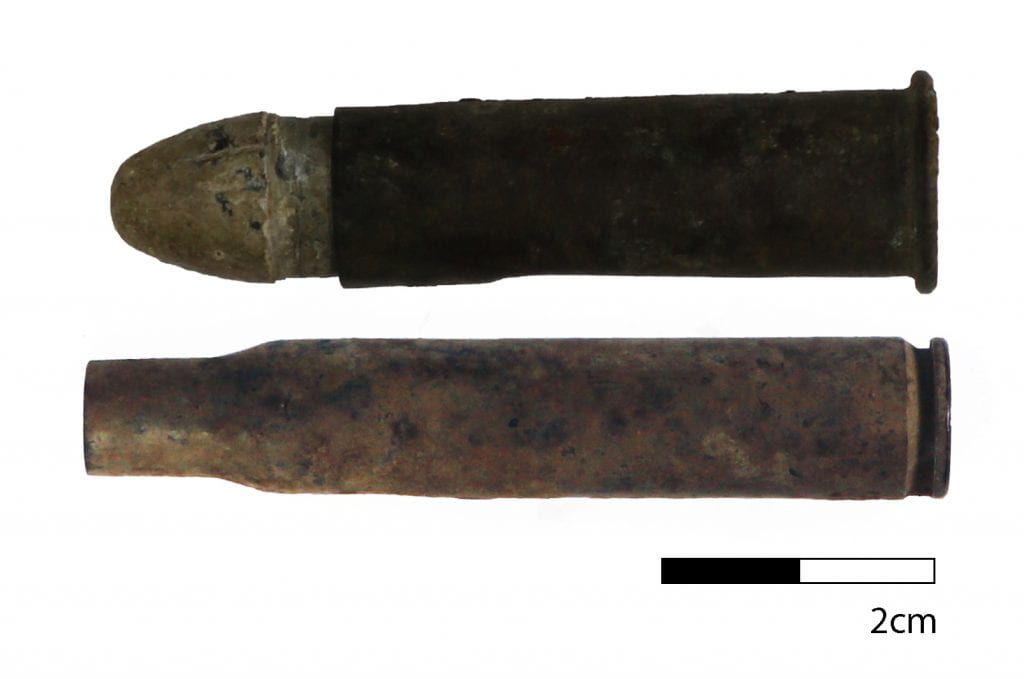Fort Richardson is a historic site located in Jacksboro, Texas. It is a post-Civil War era site occupied from 1867 to 1878 and when the site was vacated, the site was recognized as the Fort Richardson State Historic Park. Fort Richardson was a place of refuge for recently out-of-work soldiers who turned to this area to continue serving in various United States Calvaries. Fort Richardson specifically functioned as the headquarters to the Fourth, Sixth, and Tenth Calvaries as well as the Eleventh and Twenty-fourth Infantry. Family life was also a significant part of the livelihood of this site. The excavation was conducted in 1971, 1972, 1973, and 1975 and led by archaeologist Dessamae Lorrain. Excavation was funded and executed by the Archaeology Research Program at Southern Methodist University.

Fort Richardson Artifacts
Metal Artifacts
Letter C, Number 6
Material: Brass

These stamped brass pieces were either from a company or regiment number, worn on a soldier’s hat depicted below. While this hat was not found at the Fort Richardson site, this Civil-War era soldier’s hat, called a forage cap, is similar to what would have been worn at Fort Richardson.

Cartridge and Casing
Material: Brass
This center-fire rifle cartridge is from a .50-70 musket, the official U.S. military rifle from 1866 to 1873. The casing is from a different ammunition (.30-06) adopted by the military in 1906. Cartridges like this one were used for the 1903 Springfield service rifle.


Musket Ball
Material: Lead
This .60 caliber musket ball has no identifying marks but could have been used by a soldier at the fort.
Coins
Material: Nickel
Nickels, such as these from 1867 and 1902, help archaeologists date sites.

Keys
Material: Iron and Brass

This set of keys is on a brass chain and they have hollow ends to fit over a spline. The solitary key below is made from brass.

Door Lock
Material: Iron
This iron door-lock fragment would have opened one of the doors in the original fort.

Ceramic Artifacts
Creamware
Material: Ceramic

This fragment is an example of hand-painted ceramic and was probably an heirloom piece.

Doorknob
Material: Porcelain
These doorknob fragments help archaeologists locate where a building’s doors would have been.
Glass Artifacts
Vaseline Jar

Material: Glass
The imprint label on the glass indicates this jar was made by the Chesebrough Company in New York. Vaseline jars like these were manufactured by Robert Chesebrough, who discovered petroleum jelly. He began marketing Vaseline in 1872 as a salve.
Bottle
Material: Glass
The distinctive lip ring and olive-green coloration on this bottle identifies it as a champagne bottle. The historical record indicates that the excavated area is where the officers quarters were located. This is confirmed by the presence of fine materials, such as this champagne bottle.

Marble

Material: Glass
Artifacts, like this marble with a blue glass twist, give insight into children’s lives on the site.
Further Reading
https://www.tshaonline.org/handbook/entries/fort-richardson
https://tpwd.texas.gov/state-parks/fort-richardson
https://en.wikipedia.org/wiki/Fort_Richardson_(Texas)
References
Dickson, Bruce D., and William Westbury
1976 Archaeological Reserach at Fort Richardson State Park, Summer 1975: Excavation of Enlisted Man’s Barracks (L4), Picket Officer’s Quarters (J1), and Officers’ Kitchen (K5). Anthropology Laboratory Texas A&M University, Report No. 28.
About the Author
Katie Davis (SMU 2023) earned her Bachelors of Science in anthropology and psychology with a minor in art history. Katie is worked for the SMU Archaeology Research Collections as an undergraduate research assistant and her first project was creating this digital exhibit. On-campus, Katie was also a Resident Assistant in underclassman housing, a member of the University Conduct Board, and a general member of Student Foundation.
 Hillary Barron (SMU 2021) is an empathetic researcher dedicated to preserving and telling the stories of cultures who no longer have a voice. She received her B.A. in anthropology and religious studies. She plans to embark on a career in curation or collections management within museums. She is driven to pursue an M.A in museum studies because of her passion for preservation and care of material culture. As Vice President of Membership for the Anthropology Club at SMU, she was able to advocate the importance of anthropological research to different majors to the SMU student body.
Hillary Barron (SMU 2021) is an empathetic researcher dedicated to preserving and telling the stories of cultures who no longer have a voice. She received her B.A. in anthropology and religious studies. She plans to embark on a career in curation or collections management within museums. She is driven to pursue an M.A in museum studies because of her passion for preservation and care of material culture. As Vice President of Membership for the Anthropology Club at SMU, she was able to advocate the importance of anthropological research to different majors to the SMU student body.